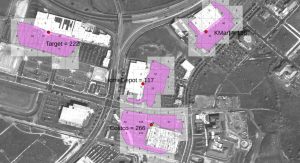- Opportunity
The recent increase in the number of satellites, providing multi-spectral, full-earth coverage at rapidly decreasing cost, provides significant opportunity to achieve business insights through the analysis of real-time or near real-time high-resolution satellite imagery. When coupled with significant increases in computing power and cloud computing networking, companies can use machine learning algorithms to interpret, analyze, and process imagery data to solve business problems across a large number of applications. At a simplistic level, “picture-takers,” or companies that operate a constellation of satellites, capture images in multiple spectrums (visible, infrared, radar, etc) of the earth at high resolution (down to 30 cm) for further processing. Next, a “sense-making” company accesses the data and analyzes it by comparing different images of the same object, aggregated across multiple objects and periods of time, in order to provide business insights for the given application. One of the leading companies in analyzing this satellite imagery is Orbital Insight.
- Summary of Solution
While some satellite companies also perform the subsequent analysis, Orbital Insight is purely a “sense-maker.” They are experts in getting useful aggregate information out of the satellite images. In order to do this, they employ proprietary machine learning and computer vision algorithms to observe changes in specific activities or resources which are visible in or can be deduced from the satellite images. The algorithms are trained to identify specific features in the images, like cars in a parking lot, crops in a field, or oil tankers at sea, and quantify them. In doing so, Orbital Insight can preempt commodity trends or estimate non-public information regarding a company’s performance. They partner with several key satellite constellation owners to gain access to higher quality, more complete, or more frequently updated satellite imagery.
- Evaluate Effectiveness / Commercial Premise
Orbital Insight solves business problems through both industry and product-specific channels. While Orbital Insight currently does the majority of its business through product-specific channels, analysis gleaned from satellite imagery can be applied to almost every industry where insight is possible through monitoring global trends or competitor performance. Among others, notable consumers of Orbital Insight’s analysis include retail, energy, financial services, agriculture, insurance, and government. By using satellite imagery, for example, Orbital Insight is able to forecast U.S. corn and soy production with predictive crop yield analytics through merging rich satellite data, weather and historical data in real time to provide investment-grade insights to a variety of clients including hedge funds, asset managers and financial data service providers before commercial and government statistics are available. In another application, Orbital Insight used satellite imaging in the aftermath of Hurricane Harvey to refine their model predicting flooding for their insurance company clients. Orbital Insight’s use of machine learning and data analytics applied to satellite imaging can provide customers with both valuable investment insights and business solutions.
- Competitive Landscape
As mentioned previously, the competitive landscape in the satellite imaging market is largely divided between “picture-takers” and “sense-makers,” and some companies try to span both business models. As a result, Orbital Insight competes against both imaging companies that perform analysis (e.g. Planet Labs) and companies with no satellites who focus solely on analysis (eg, Descartes Labs). While the satellite imaging industry (i.e. the “picture-takers”) is projected to be a $6.8B industry by 2023, the satellite imagery analysis industry in which Orbital Insight competes is less mature and composed largely of private companies, spanning industries that produce trillions of dollars in annual revenues. There are very few barriers to entry for imagery analysis, and thus Orbital Insights achieves its competitive advantage through partnerships with a number of the “picture-takers,” where the quality of analysis produced from its algorithms is higher due to Orbital Insight having access to more timely images sourced from different data streams (i.e. multi-spectral), and its leading proprietary machine learning algorithms. While Orbital Insight is a private company that was founded very recently, with a valuation of approximately $230M, DigitalGlobe, a leading public imaging and analysis company, provides an idea of the size of potential revenues, achieving $725M in revenue in 2016.
- Proposed Alterations to Increase Value
Orbital Insight has a strong business model with a clear value proposition, but operates in a competitive field with low barriers to entry. They are entirely at the mercy of the “picture-takers” and are squeezed at both sides of the stack with little likelihood to succeed through vertical integration. In order to succeed in the space, they should differentiate themselves on algorithm performance and take measures to protect their methods. If they are known as the player that can most accurately predict commodity trends and extract the most value from satellite images, then they will have a place in the ecosystem. Since the software patent landscape has varying levels of effectiveness based on the applicable country, is complicated, and in a state of flux, Orbital Insight should be more proactive than the average company in protecting its IP. Lastly, in order to not be beholden to any single upstream firm which may itself try to vertically integrate, they should also make efforts to expand the number of partners in the satellite imaging industry. This will ensure that satellite imagery continues to be a widely available product, allowing companies like Orbital Insight to benefit from an ever-expanding amount of data.
Sources
Newsweek
http://www.newsweek.com/2016/09/16/why-satellite-imaging-next-big-thing-496443.html
AI Applications for Satellite Imagery and Satellite Data
https://www.techemergence.com/ai-applications-for-satellite-imagery-and-data/
How AI Could (Really) Enhance Images from Space
https://www.wired.com/story/how-ai-could-really-enhance-images-from-space/
Global Commercial Satellite Imaging Market Size, Share, Development, Growth and Demand Forecast to 2023 – Industry Insights by Application, and by End-User
https://www.researchandmarkets.com/research/dq6sc4/global_commercial
Orbital Insight Sees the Big Picture with AI
https://www.nanalyze.com/2017/01/orbital-insight-artificial-intelligence/
How Orbital Insight Measured Hurricane Harvey’s Flooding Through the Clouds
DigitalGlobe Form 10-K
https://www.sec.gov/Archives/edgar/data/1208208/000155837017001064/dgi-20161231x10k.htm
Patent Protection for Software-implemented Inventions
http://www.wipo.int/wipo_magazine/en/2017/01/article_0002.html
Team Members
Thomas DeSouza, Matthew Nadherny, Patrick Rice, Samuel Spletzer


=)